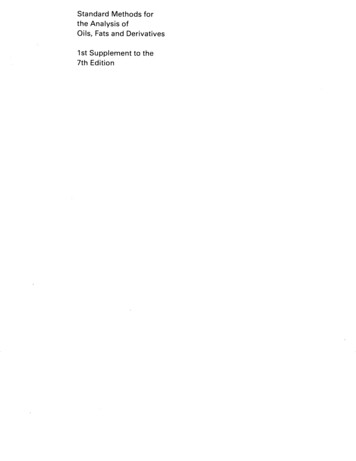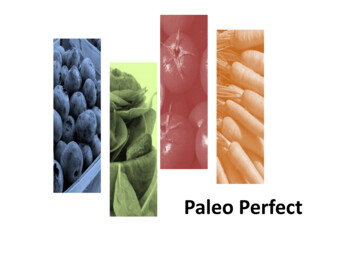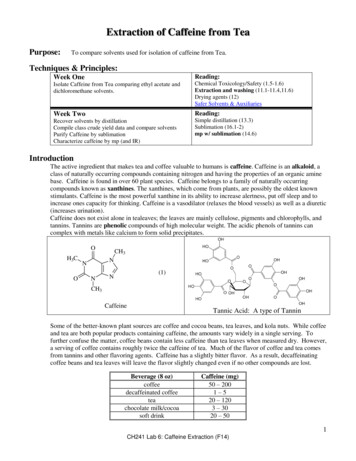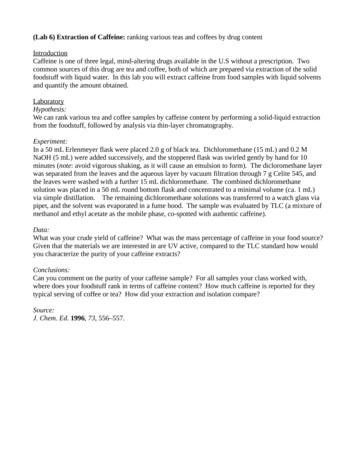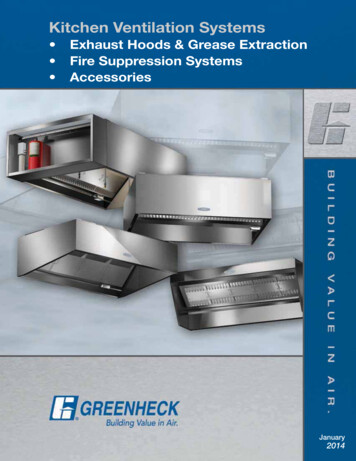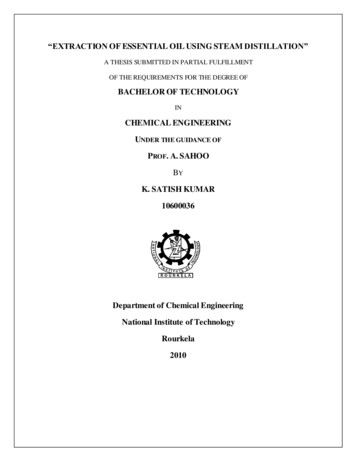
Transcription
“EXTRACTION OF ESSENTIAL OIL USING STEAM DISTILLATION”A THESIS SUBMITTED IN PARTIAL FULFILLMENTOF THE REQUIREMENTS FOR THE DEGREE OFBACHELOR OF TECHNOLOGYINCHEMICAL ENGINEERINGUNDER THE GUIDANCE OFPROF. A. SAHOOBYK. SATISH KUMAR10600036Department of Chemical EngineeringNational Institute of TechnologyRourkela2010
National Institute of TechnologyRourkelaCERTIFICATEThis is to certify that the thesis entitled, “Extraction of Essential oil using steam distillation”submitted by K. Satish kumar in partial fulfillments for the requirements for the award ofBachelor of Technology Degree in Chemical Engineering at National Institute of Technology,Rourkela is an authentic work carried out by him under my supervision and guidance.To the best of my knowledge, the matter embodied in the thesis has not been submitted to anyother University / Institute for the award of any Degree or Diploma.Date:RourkelaProf. (Mrs.) A. SahooDept. of Chemical Engineering,National Institute of Technology,Rourkela - 769008, Orissa
ACKNOWLEDGEMENTI would like to make my deepest appreciation and gratitude to Prof. (Mrs.) A. Sahoo for hisvaluable guidance; constructive criticism and encouragement during every stage of this project. Ithank Dr. H.M.Jena for acting as the project coordinator. I am grateful to Prof. S.K.Agarwal,Head of the Department, and Chemical Engineering for providing me the necessary opportunitiesfor the completion of my project. I also thank other staff members of my department for theirinvaluable help and guidance.RourkelaDate:K.SATISH KUMAR10600036Dept. of Chemical Engineering,National Institute of Technology,Rourkela
ABSTRACTA large number of herb materials contain Essential Oils with extensive bioactivities.Acknowledging the importance of plants and its medicinal value, extraction of Essential Oil hadbeen done using Steam Distillation method. In this project Steam Distillation was used to extractoil from different plant materials like eucalyptus leaves, curry leaves, hibiscus leaves, lemonleaves, marigold flowers, rose flowers, orange peels etc. Research has confirmed centuries ofpractical use of essential oils, and we now know that the 'fragrant pharmacy' contains compoundswith an extremely broad range of biochemicaleffects. Essential oils are so termed as they arebelieved to represent the very essence of odor and flavor. The recovery of Essential Oil (thevalue added product) from the raw botanical starting material is very important since the qualityof the oil is greatly influenced during this step. There are a variety of methods for obtainingvolatile oils from plants. Steam distillation method was found to be one of the promisingtechniques for the extraction of essential oil from plants as reputable distiller will preserve theoriginal qualities of the plant. Thedistillation was conducted in Clevenger apparatus in whichboiling, condensing and decantation was done. Analysis of Essential oil was done using GasChromatography-Mass Spectrometer apparatus, which givesevaluates Essential Oil qualitativelyand quantitatively. Volume of Essential Oil obtained was changing w.r.t temperature and time ofheating.i
CONTENTSChapter No.Name of the contentPage No.AbstractiContentsiiList of figuresiiiList of tablesiiiChapter 1Introduction1Chapter 2Literature review32.1Definition42.2Chemical Constituents of Essential Oils62.3Advantages of essential oil112.4Methods of extraction12Chapter 3Experimental work173.1Experimental Setup183.2Experimental procedure183.3Analysis of Essential Oils193.4Experimental observation21Chapter 4Results and discussion224.1Inference234.2Graphs showing analysis of Essential Oil26Chapter 5Conclusions31Chapter 6References33ii
LIST OF FIGURESSl. no.NamePage no.1Essential Oil Steam Distiller182Flow sheet of Steam Distillation193Schematic diagram of Gas Chromatography-Mass Spectrometer204Structure of Limonene285Structure of E-phytol30LIST OF TABLESSl.no.1.NamePage no.Major Raw Material Used In Extraction of Essential Oils522. Table showing different volumes of Essential Oil extracted21from different plant materials and their time of heatingiii
CHAPTER 1INTRODUCTION1
1. INTRODUCTON:Essential oils contain highly volatile substances that are isolated by a physical method orprocess from plants of a single botanical species. The oils normally bear the name of theplant species from which they are derived. Essential oils are so termed as they are believedto represent the very essence of odor and flavor. Essential oil plants and culinary herbsinclude a broad range of plant species that are used for their aromatic value as flavorings infoods and beverages and as fragrances in pharmaceutical and industrial products. Essentialoils derive from aromatic plants of many genera distributed worldwide.Oils are used in the embalming process, in medicine and in purification rituals. There arealso over 200 references to aromatics, incense and ointments in the Old and New Testaments.Research has confirmed centuries of practical use of Essential Oils, and we now know thatthe 'fragrant pharmacy' contains compounds with an extremely broad range of biochemicaleffects. There are about three hundred essential oils in general use today by professionalpractitioners. Continual bombardment of viral, bacterial, parasitic and fungal contaminationoccurs in our body. Essential oils are a great benefit to help protect our bodies and homesfrom this onslaught of pathogens. Immune system needs support and these essential oils cangive the required endorsement. [1]Steam distillation is used in the extraction of Essential Oil from the plant material. It is aspecial type of distillation or a separation process for temperature sensitive materials likeoils, resins, hydrocarbons, etc. which are insoluble in water and may decompose at theirboiling point. The fundamental nature of steam distillation is that it enables a compound ormixture of compounds to be distilled at a temperature substantially below that of the boilingpoint(s) of the individual constituent(s). Essential Oil contains components with boilingpoints up to 200 C or higher temperatures. In the presence of steam or boiling water,however, these substances are volatilized at a temperature close to 100 C, at atmosphericpressure. [2]Analysis of Essential Oil is done by using Gas Chromatography with Mass Spectrometer.The qualitative and quantitative analysis is done to know the constituents in the oil and thepercentage of components present in the oil respectively, by doing so we can know the purityof that particular oil. [3]2
CHAPTER 2LITERATURE REVIEW3
It is estimated that there are 250,000 to 500,000 species of plants on Earth. A relatively smallpercentage (1 to 10%) of these is used as foods by both humans and other animal species. It ispossible that even more are used for medicinal purposes (Moerman, D. E. 1996). Moerman(1996) reported that while 625 species of plants have been used by various Native Americangroups as food, 2,564 have found use as drugs. According to his calculations, this leavesapproximately 18,000 species of plants which were used for neither food nor drugs. [4]Plant oils and extracts have been used for a wide variety of purposes for many thousandsof years (Jones 1996). These purposes vary from the use of rosewood and cedar wood inperfumery, to flavoring drinks with lime, fennel or juniper berry oil, and the application oflemongrass oil for the preservation of stored food crops. In particular, the antimicrobial activityof plant oils and extracts has formed the basis of many applications, including raw and processedfood preservation, pharmaceuticals, alternative medicine and natural therapies.Since ancient times, herbs and their essential oils have been known for their varyingdegrees of antimicrobial activity. More recently, medicinal plant extracts were developed andproposed for use in food as natural antimicrobials.2.1 DEFINITION:An essential oil is a concentrated, hydrophobic liquid containing volatile aroma compounds fromplants. Essential oils are also known as volatile, ethereal oils or aetherolea, or simply as the "oilof" the plant from which they were extracted, such as oil of clove. Oil is "essential" in the sensethat it carries a distinctive scent, or essence, of the plant. [5]Essential oils are frequently referred to as the “life force ” of plants. These "essential" oilsare extracted from flowers, leaves, stems, roots, seeds, bark, and fruit rinds. The amount ofessential oils found in these plants can be anywhere from 0.01 percent to 10 percent of the total.These oils have potent antimicrobial factors, having wide range of therapeutic constituents.These oils are often used for their flavor and their therapeutic or odoriferous properties, in a wideselection of products such as foods, medicine, and cosmetics. Only pure oils contain a fullspectrum of compounds that cheap imitations simply cannot duplicate.[5]4
Table-2.1Major Raw Material Used In Extraction of Essential Oils:LeavesFlowe Bay leafClary SageGrape alyptusGeraniumLimeCuminSandalwoodLemon GrassHyssopOrangeNutmeg ang-YlangTangerineTea monMyrrh5
2.2 CHEMICAL CONSTITUENTS OF ESSENTIAL OILS: AnEssential Oilcontains more than 200 chemical components, but some are many times more complex. Essentialoils consist of chemical compounds which have hydrogen, carbon and oxygen as their buildingblocks. [12] They can be essentially classified into two groups:Volatile fraction: Essential oil constituting of 90–95% of the oil in weight, containing themonoterpene and sesquiterpene hydrocarbons, as well as their oxygenated derivatives along withaliphatic aldehydes, alcohols, and esters.Nonvolatile residue:This comprises 1–10% of the oil, containing hydrocarbons, fatty acids,sterols, carotenoids, waxes, and flavonoids.However the properties of these components can change. For example, the components from theoils extracted from plants can change according to how, when and where these plants are grownand harvested.[6] The constituents can be again subdivided into 2 groups, such as thehydrocarbons which are made up of mostly terpenes and the oxygena ted compounds which aremainly alcohols, aldehydes, esters, ketones, phenols and oxides. Some of the commoncomponents are listed below along with their properties. Alcohols:Alcohols are generally considered safe and have a very low or totally absent toxicreaction in the body or on the skin and so can be used on children. They are extremelyuseful due to their antiviral, antibacterial and antiseptic properties. Alcohols are presenteither as a free compound or combined with a terpene or ester and are found in ylang ylang and lavender as linalool, geraniol in geranium and palmarosa and citronellol foundin rose, lemon and eucalyptus. Other alcohols include menthol, nerol and benzyl alcohol. Alderhydes:Alderhydes are found in lemon-scented oils such as Melissa, lemon verbena, citronellaetc. and include citral, citronellal and neral. They generally have sedative qualities withspecific antiseptic properties. Other known alderhydes include benzaldehyde, cinnamicalderhyde and perillaldehyde. Essential oils containing alderhydes are helpful in treatinginflammation, Candida and viral infections.[6]6
Hydrocarbon:Building blocks of Essential Oil are hydrogen and carbon. Basic Hydrocarbon found inplants is isoprene having the following structure.(Isoprene) Terpenes:These components generally have names ending with “ene ”.Some of them are limonene,pinene, piperene, camphene etc. These components act as an antibacteria l, antiviral,antiinflammatory, antiseptic, antiviral and bactericidal. These are further categorizedintomonoterpene, sesquiterpene and diterpenes. When two of theisoprene units are joinedhead to tail, the result is a monoterpene, when three are joined, it’s a sesquiterpene andsimilarly four linked isoprene units are diterpenes. [11] Monoterpene [C10 H16 ]:Monoterpene are naturally occurring compounds, the majority being unsaturatedhydrocarbons (C 10 ).But some of their oxygenated derivatives such as alcohols, Ketones,and carboxylic acids known as monoterpenoids.(Limonene)(Menthol)7
Two isoprene units are present in these branched-chain C10 hydrocarbons and are widelydistributed in nature with more than 400 naturally occurring monoterpenes. Moreover,besides being linear derivatives (Geraniol, Citronellol), the monoterpenes can be cyclicmolecules (Menthol – Monocyclic; Camphor – bicyclic; Pinenes (αand β) – Pine generaas well. Thujone (a monoterpene) is the toxic agent found in Artemisiaabsinthium(wormwood) from which the liqueur absinthe, is made. Borneol and camphor are twocommon monoterpenes. Borneol, derived from pine oil is used as a disinfectant anddeodorant. Camphor is used as a counterirritant, anesthetic, expectorant, and antipruritic,among many other uses. Sesquiterpene:Sesquiterpenes are biogenetically derived from farensyl pyrophosphate and in structuremay be linear, monocyclic or bicyclic. They constitute a very large group of seco ndarymetabolites, some having been shown to be stress compounds formed as a result ofdisease or injury.These are having properties like anti- inflammatory, anti-septic,analgesic and anti-allergic. Sesquiterpene Lactones:These are available as farnesene in chamomile and lavender. They not only have provedto be of interest from chemical and chemotaxonomic point of view, but also possessmany antitumor, anti- leukemia, cytotoxic and antimicrobial activities.Chemically the compounds can be classified according to their carboxylic skeletons; thus,guaianolides, pseudoguaianolides, eudesmanolides, eremophilanolides, xanthanolides,etc. can be derived from the germacranolides.8
Structural features of all these compounds are associated with much of the biologicalactivity. For example beta-caryophyllene in basil and black pepper Diterpenes:Isoprene has been an integral part in most of the components as there are four isopreneunits in Diterpenes. By Stem Distillation method we cannot detect Diterpenes as thismolecule is too heavy to allow for evaporation, so it is rarely found in distilled EssentialOils. Diterpenes occur in all plant families and consist of compounds having a C20skeleton. There are about 2500 known Diterpenes that belong to 20 major structuraltypes. Derivatives of Diterpenes areplant hormones Gibberellins and phytol occurring asa side chain on chlorophyll. The biosynthesis occurs in plastids and interestingly mixturesof monoterpenes and diterpenes are the major constituents of plant resins. In a similarmanner to monoterpenes, Diterpenes arise from metabolism of geranyl geranylpyrophosphate (GGPP). Therapeutically Diterpenes have limited importance and are usedin certain sedatives (coughs) as well as in antispasmodics and anxiolytics. Alcohols:Naturally Alcohols exist either as a free compound or combined with a terpenes or ester.When terpenes are attached to an oxygen atom, and hydrogen atom, the result is analcohol. When the terpene is monoterpene, the resulting alcohol is called a monoterpenol.Alcohols are not and are suitable to body or skin. Therefore, they are considered safe touse.Some of these properties areanti-septic, anti-viral, bactericidal and germicidal. Someof the examples are linalool found in ylang-ylang and lavender, geraniol in geranium androse and nerol in neroli.9
Aldehydes:Aldehyde containing Essential Oils are effective in treating candida and other fungalinfections. Some of these properties are anti- fungal, anti- inflammatory, anti-septic, antiviral, bactericidal, disinfectant, and sedative. Aldehydes are present as citral in lemon,Citronellal in lemongrass, lemon balm and citrus eucalyptus. Acids:Generally Organic acids are found in very small quantities in their free state withinEssential Oils. Plant acids act as components or buffer systems to control acidity. Thesealso act anti- inflammatory. Examples are cinnamic and benzoic acid in benzoin, Citricand lactic. Esters:Esters are formed through the reaction of alcohols with acids. Essential oils containingesters are used for their soothing, balancing effects. Because of the presence of alcohol,they are effective antimicrobial agents. Medicinally, esters are characterized as antifungaland sedative, with a balancing action on the nervous system. They generally are free fromprecautions with the exception of methyl salicylate found in birch and wintergreen whichis toxic within the system. Examples are linlyl acetate in bergamot and lavender andGeranyl formate in geranium. [15] Ketones:Ketones found in plants are used for upper respiratory complaints. They assist the flow ofmucus and ease congestion. Essential oils containing ketones are beneficial for promotingwound healing and encouraging the formation of scar tissue. Ketones are (not always)very toxic. The most toxic ketone is Thujone found in mugwort, sage, tansy, thuja andwormwood oils. Other toxic ketones found in essential oils are pulegone in pennyroyal,and pinocamphone in hyssops. Some non-toxic ketones are jasmone in jasmine oil,fenchone in fennel oil, carvone in spearmint and dill oil and menthone in peppermint oil. Lactones:Lactones are known to be particularly effective for their anti- inflammatory action,possibly by their role in the reduction of prostaglandin synthesis and expectorant actions.Lactones have an even stronger expectorant action than ketones.10
2.3ADVANTAGES OF ESSENTIAL OIL: AROMATHERAPHY: Aromatherapy is a form of alternative medicine that usesvolatile plant materials, known as essential oils, and other aromatic compounds for thepurpose of altering a person's mood, cognitive function or health. Science has discoveredthat our sense of smell plays a significant role in our overall health.[8]Since ancient times Essential Oils have been used in medicine because of their medicinalproperties, for example some oils have antiseptic properties. In addition, many have anuplifting effect on the mind, though different essential oils have different properties.Working of Essential Oil in Aromathe rapy: when Essential Oil is inhaled it goesdirectly from olfactory system to limbic system of the brain. Brain responds to theparticular scent affecting our emotions and chemical balance. Essential Oils alsoabsorbed by the skin and carried throughout the body via the circulatory system to reachall internal organs.We can be benefited by choosing carefully the desired and suitable oils which canpromote overall health. Benefits depend upon the unique nature of each perso n’sresponse to an aromatic stimulus. [1] Importance of Essential Oil in pharmaceutics: Essential Oils have versatileapplications in pharmaceutics. Some of the applications are listed below.Antiseptics: The antiseptic properties of Essential Oil make them active against widerange of bacteria as on antibiotic resistant strains. In addition to this they are also againstfungi and yeasts. The most common sources of essential oils used as a ntiseptics are:Cinnamon, Thyme, Clover, Eucalyptus,Culinsavory,and Lavender. Citral, geraniol,linalool and thymol are much more potent than phenol. [1]Expectorants and diuretics: When used externally, essential oils like (L’essence deterebenthine) increase microcirculation and provide a slight local anesthetic action. Tillnow, essential oils are used in a number of ointments, cream and gels, whereby they areknown to be very effective in relieving sprains and other articular pains. Oraladministration of essential oils like eucalyptus or pin oils, stimulate ciliated epithelialcells to secrete mucus. On the renal system, these are known to increase vasodilation andin consequence bring about a diuretic effect.11
Spasmolytic and sedative: Essential oils from the Umbellifereae family, Mentha speciesand verbena are reputed to decrease or eliminate gastrointestinal spasms. These essentialoils increase secretion of gastric juices. In other cases, they are known to be effectiveagainst insomnia.2.4.1 METHODS OF EXTRACTION: The following are the methods of extraction ofEssential Oil and their drawbacks.2.4.1Solvent-Extraction:In the Solvent-Extraction method of Essential Oils recovery, an extracting unit is loadedwith perforated trays of essential oil plant material and repeatedly washed with thesolvent. A hydrocarbon solvent is used for extraction. All the extractable materialfrom the plant is dissolved in the solvent. This includes highly volatile aroma moleculesas well as non-aroma waxes and pigments. The extract is distilled to recover the solventfor future use. The waxy mass that remains is known as the concrete. The concentratedconcretes are further processed to remove the waxy materials which dilute the pureessential oil. To prepare the absolute from the concrete, the waxy concrete is warmed andstirred with alcohol (ethanol). During the heating and stirring process the concrete breaksup into minute globules. Since the aroma molecules are more soluble in alcohol than thewaxes, an efficient separation of the two results. This is not considered the best method forextraction as the solvents can leave a small amount of residue behind which could causeallergies and effect the immune system.2.4.2Maceration:Maceration actually creates more of “infused oil” rather than an Essential Oil. Plantmatter is soaked in vegetable oil, heated and strained at which point it can be used formassage. This method is not desirable because it changes the composition of oil.2.4.3Cold Pressing:This method is used to extract the Essential Oils from citrus rinds such as orange, lemon,grapefruit and bergamot. This method involves the simple pressing of the rind at about120 degrees F to extract the oil. The rinds are separated from the fruit, are ground orchopped and are then pressed. The result is a watery mixture of essential oil and12
liquidwhich will separate given time. Little alteration from the oil's original state occurs –these citrus oils retain their bright, fresh, up lifting aromas like that of smelling awonderfully ripe fruit. The drawback of this method is, oils extracted using this methodhave a relatively short shelf life.2.4.4Effleurage:This is one of the traditional ways of extracting oil from flowers. The process involveslayering fat over the flower petals. After the fat has absorbed the essential oils, alcohol isused to separate and extract the oils from the fat. The alcohol is then evaporated and theEssential Oil is collected. [13]2.4.5Super Critical CO2 Extraction:Supercritical CO2 extraction (SCO2) involves carbon dioxide heated to 87 degrees F andpumped through the plant material at around 8,000 psi, under these conditions; the carbondioxide is likened to a 'dense fog' or vapor. With release of the pressure in either process,the carbon dioxide escapes in its gaseous form, leaving the Essential Oil behind. Theusual method of extraction is through steam distillation. After extraction, the propertiesof a good quality essential oil should be as close as possible to the "essence" of theoriginal plant.The key to a 'good' essential oil is through low pressure and lowtemperature processing. High temperatures, rapid processing and the use of solvents alterthe molecular structure, will destroy the therapeutic value and alter the fragrance. [10]2.4.6Turbo Distillation Extraction:Turbo distillation is suitable for hard-to-extract or coarse plant material, such as bark,roots, and seeds. In this process, the plants soak in water and steam is circulated throughthis plant and water mixture.Throughout the entire process, the same water iscontinually recycled through the plant material. This method allows faster extraction ofessential oils from hard-to-extract plant materials.Dr.A.Sahoo et al have studied that Steam Distillation is a special type of distillation or aseparation process for temperature sensitive materials like oils, resins, hydrocarbons, etc.which are insoluble in water and may decompose at their boiling point. The temperatureof the steam must be high enough to vaporize the oil present, yet not so high that it13
destroys the plants or burns the essential oils. The experiment has been carried out for theextraction of oil from Eucalyptus which has high essential oil content. Such Eucalyptusessential oil, which have been used as perfume and chemical raw materials for a longtime, are now been studied as renewable sources of energy.G. Anitescu et al have studied that ripe fruits of Coriander sativum L. were extracted bysteam distillation and by supercritical fluid extraction (SFE),using CO2 in a two-stageseparation system. An inexpensive thermal expansion procedure for supercritical fluiddelivery has been developed. The identification of components was performed by gaschromatography and mass spectrometry (GC MS). The percentage composition of the 40identified compounds was compared with the composition of commercial coriander oilextracted by hydro distillation.Roy Teranishi et al have studied that system combines steam distillation and liquid-liquidextraction to recover volatiles from fats and oils. Oil is pumped in at the top of aspinning-band distillation column, in which the oil is heated to100 "C and spread to a thinfilm. As the oil film drops down to the pot, steam, which is introduced at the bottom,travels upward to strip the volatiles from the oil. The steam distillate is extracted inliquid- liquid extractor incorporated in the system, and the extracted water is recycled assteam. Stripped oil in the pot serves as a liquid seal to force steam up the column. Thelevel of the oil in the pot is maintained automatically by an overflow system. Many litersof oil can be pumped through this system to be stripped of volatiles by steam. Thevolatiles can be isolated easily from the small amount of solvent recycled in the liquidliquid extractor.Referring to the above literature review, it was found that Steam Distillation method is anappropriate and economical method for extraction of Essential Oil.2.4.7Extraction of Essential Oils Using Steam distillation Method:Steam distillation is a special type of distillation or a separation process for temperaturesensitive materials like oils, resins, hydrocarbons, etc. which are insoluble in water andmay decompose at their boiling point. The fundamental nature of steam distillation is thatit enables a compound or mixture of compounds to be distilled at a temperaturesubstantially below that of the boiling point(s) of the individual constituent(s). Essential14
oils contain substances with boiling points up to 200 C or higher temperatures. In thepresence of steam or boiling water, however, these substances are volatilized at atemperature close to 100 C, at atmospheric pressure.Fresh, or sometimes dried, botanical material is placed in the plant chamber of the stilland the steam is allows to pass through the herb material under pressure which softensthe cells and allows the Essential Oil to escape in vapor form. The temperature of thesteam must be high enough to vaporize the oil present, yet not so high that it destroys theplants or burns the EssentialOils. Besides the steam tiny droplets of Essential Oilevaporates and travel through a tube into the still's condensation chamber. Here EssentialOil vapors condense with the steam. The essential oil forms a film on the surface of thewater. To separate the Essential Oil from the water, the film is then decanted or skimmedoff the top. The remaining water, a byproduct of distillation, is called floral water,distillate, or hydrosol. It retains many of the therapeutic properties of the plant, making itvaluable in skin care for facial mists and toners (A solution containing chemicals that canchange the color of a photographic print). In certain situations, floral water may bepreferable to be pure essential oil, such as when treating a sensitive individual or a child,or when a more diluted treatment is required. Rose hydrosol, for example, is commonlyused for its mild antiseptic and soothing properties, as well as its pleasing floral aroma.A number of factors determine the final quality of a steam distilled essential oil. Apartfrom the plant material, most important are time, temperature and pressure, and thequality of the distillation equipment. Essential oils are very complex products. Each ismade up of many, sometimes hundreds, of distinct molecules which come together toform the oil's aroma and therapeutic properties. Some of these molecules are fairlydelicate structures which can be altered or destroyed by adverse environmentalconditions. So, much like a fine meal is more flavorful when made with patience, mostoils benefit from a long, slow 'cooking' process. [9] It is possible that longer distillationtimes may give more complete oil. It is also possible however, that longer distillationtime may lead to the accumulation of more artifacts than normal. This may have a curiouseffect of appearing to improving the odor, as sometimes when materials that have a largernumber of components are sniffed, the perception is often of slightly increasedsophistication, added fullness and character, and possibly, and extra pleasantness.15
Advantages of using Steam Distillation:The advantage of Steam Distillation is that it is a relatively cheap process to operate at abasic level, and the properties of oils produced by this method are not altered. As steamreduces the boiling point of a particular component of the oil, it never decomposes in thismethod. This method apart from being economical, it is also relatively faster than othermethods.16
CHAPTER 3EXPERIMENTAL WORK17
3.1 Experimenta
Essential oils are frequently referred to as the “life force” of plants. These "essential" oils are extracted from flowers, leaves, stems, roots, seeds, bark, and fruit rinds. The amount of essential oils found in these plants can

